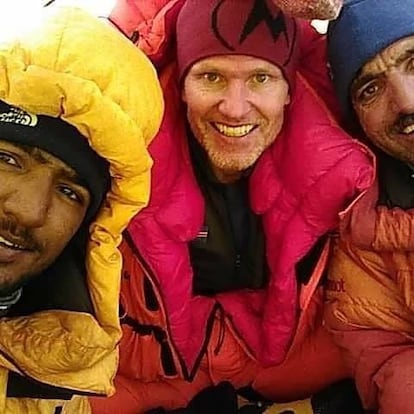What should be done with the corpses of climbers in the Himalayas?
The recent discovery of the remains of three mountaineers on K2 has reignited debate over the lack of a protocol for recovering bodies from the world’s highest peaks
The bodies of three climbers – Ali Sapdara from Pakistan, Icelander John Snorri and Chilean Juan Pablo Mohr – were found last month, on July 26, after going missing for almost six months in the highest part of K2, the world’s second-highest mountain (8,611 meters). A team of Nepalese Sherpas came across them as they ascended the standard Abruzzi Spur route.
The last person to see the trio alive during the fierce Karakorum winter was Ali Sapdara’s son, Sajid Sapdara: at first light on February 5, his artificial oxygen regulator failed and he decided to forego the summit. The temperature hovered around -40ºC as the remaining group tackled the notoriously challenging Bottle Neck. Without realizing it, Sajid was saying a last goodbye to his father, his father’s client, John Snorri, and the Chilean Mohr. Mohr himself was ascending without the aid of artificial oxygen, determined to reach the summit as a tribute to his Spanish friend, Sergi Mingote, who had died a few days earlier while working on his acclimatization. The dwindling team aimed to be the first to summit K2 in winter. The weather window was small. Fatally so. When a climber dies, the pain and the unanswered questions of his family begin.

The Sherpas came across the remains of Mohr at 7,955 meters, very close to where the last altitude camp, Camp 4, is often located before the final leg to the summit. On February 5, from within his tent at Camp 3 (7,330 meters), Sajid kept a light on through the night to guide the trio, though he never saw them. Ali’s body was found at 8,300 meters, attached to a fixed rope, as was Snorri’s, just a few meters above him. All died on the way down, as indicated by the descent devices attaching Ali and Snorri’s harnesses to the fixed ropes. The night they set off for the summit, the intensity of the wind increased. Their deaths were almost certainly caused by fatigue and extreme cold. The discovery of the bodies on July 26 was a relief to Sajid, who was also back on the mountain in search of their remains. He was obsessed with the idea of finding out what happened after he was separated from the group: did they reach the summit? Did they have an accident? Sajid recovered cameras, GPS and watches from the bodies in a bid to reconstruct the three climbers’ journey to the peak. The full story is not yet known, though it is clear they neither got lost nor had an accident.
The more delicate question, of course, was what to do with the remains. At first there was speculation that the bodies would be removed from the mountain with the help of helicopters, but to fly a helicopter at 8,000 meters is extremely difficult. Nor is it easy to get the bodies down the mountain – that would involve many mountaineers who would be subjected to a high level of risk. Finally, Sajid got help from Bolivian Hugo Ayaviri to move his father from 8,300 meters to a point near Camp 4 at 7,900 meters, where he buried him, according to his mother’s instructions, involving a religious ritual. He also buried the remains of Snorri and Mohr where they lay and is still deciding whether it is possible to bring them further down the mountain.
In Europe, as on the rest of the “accessible” western peaks, mountaineers’ bodies are always recovered. But in mountain ranges as remote as the Himalayas, the rescue of corpses is much more complex and risky, and many are never brought home. Everest is the most notorious for this as summit parties report having come face to face with death en route. There is no law that requires the recovery of these remains, so it is up to the families to decide what to do, a decision that can be heartbreaking.
Basque climber Félix Iñurrategi died before his brother Alberto’s eyes, in 2000, during the descent of Gasherbrum II (8,035 m), the world’s 13th-highest mountain on the border between China and Pakistan. His body fell down a precipice off the actual route onto an impassable glacier. Alberto decided that this would be his brother’s grave. “I’ve since passed the area where Felix fell three times, but I’ve never even tried to go there,” he says. “If it had been on the route, I don’t know what I would have decided... I suppose that when he fell in a place with such complicated access, the question resolved itself. The truth is that mountaineering is an activity lacking established laws,” he adds. “So everyone interprets them in their own way, and the issue of deaths in remote mountains has not been subject to debate: no one has sat down to establish a standard protocol in these cases, like, should they be buried in a place where no one can find them? Should the bodies be brought down? There is a lack of standard criteria.”
Xabier Ormazabal, also from the Basque Country, was 23 years old when he died during the descent of Cho Oyu (8,201 m) on the China-Nepal border in 2004. He was alone on the mountain and in great shape, having recently completed the Snow Leopard, an award given to those who climb the former Soviet Union’s five highest peaks of 7,000 meters and above.
After his death, his body was left in the middle of the access route, very close to the mountain’s Camp 2, in plain sight. At first, the family wanted the body to remain right there, the place Xabi loved, but, as his brother Andoni recalls, Spanish climber Iñaki Ochoa de Olza made them see the idea was impractical.
“Iñaki told us that he knew of similar cases and that, from his experience, it would be better in the long run if the family could recover the remains and say goodbye,” says Andoni. “Besides, Xabi was in the middle of the route of a highly commercial mountain and photos of his remains would soon start circulating on the internet and that was something that would become unbearable for us. On the other hand, we didn’t want anyone to put their lives at risk recovering the body, but being at a relatively accessible altitude [7,000 meters], the Sherpa team that brought him down from the mountain was in no danger.”
After cremating the remains, the idea was to scatter Xabi’s ashes in the Aralar mountain range in the Basque Country. “But in the end my mother preferred to keep the urn,” says Andoni. “It’s important for her to have a small altar, a place to remember. What is certain is that we needed peace; we needed to be able to say goodbye, to turn the page, to continue with the pain but not with the nightmare of knowing that Xabi was lying there before the indifferent gaze of other mountaineers.”
The family refused to collect the mountain insurance. Every year, Andoni offers a short audiovisual talk pieced together from Xabi’s photographs, videos, and audios rescued from radio interviews. During the tribute, a miracle seems to happen, and Xabi comes back to life – thus fulfilling the wish of his brother of never letting his memory die.
English version by Heather Galloway.
Tu suscripción se está usando en otro dispositivo
¿Quieres añadir otro usuario a tu suscripción?
Si continúas leyendo en este dispositivo, no se podrá leer en el otro.
FlechaTu suscripción se está usando en otro dispositivo y solo puedes acceder a EL PAÍS desde un dispositivo a la vez.
Si quieres compartir tu cuenta, cambia tu suscripción a la modalidad Premium, así podrás añadir otro usuario. Cada uno accederá con su propia cuenta de email, lo que os permitirá personalizar vuestra experiencia en EL PAÍS.
¿Tienes una suscripción de empresa? Accede aquí para contratar más cuentas.
En el caso de no saber quién está usando tu cuenta, te recomendamos cambiar tu contraseña aquí.
Si decides continuar compartiendo tu cuenta, este mensaje se mostrará en tu dispositivo y en el de la otra persona que está usando tu cuenta de forma indefinida, afectando a tu experiencia de lectura. Puedes consultar aquí los términos y condiciones de la suscripción digital.
Archived In
Últimas noticias
Most viewed
- Oona Chaplin: ‘I told James Cameron that I was living in a treehouse and starting a permaculture project with a friend’
- Sinaloa Cartel war is taking its toll on Los Chapitos
- Reinhard Genzel, Nobel laureate in physics: ‘One-minute videos will never give you the truth’
- Why the price of coffee has skyrocketed: from Brazilian plantations to specialty coffee houses
- Silver prices are going crazy: This is what’s fueling the rally









































